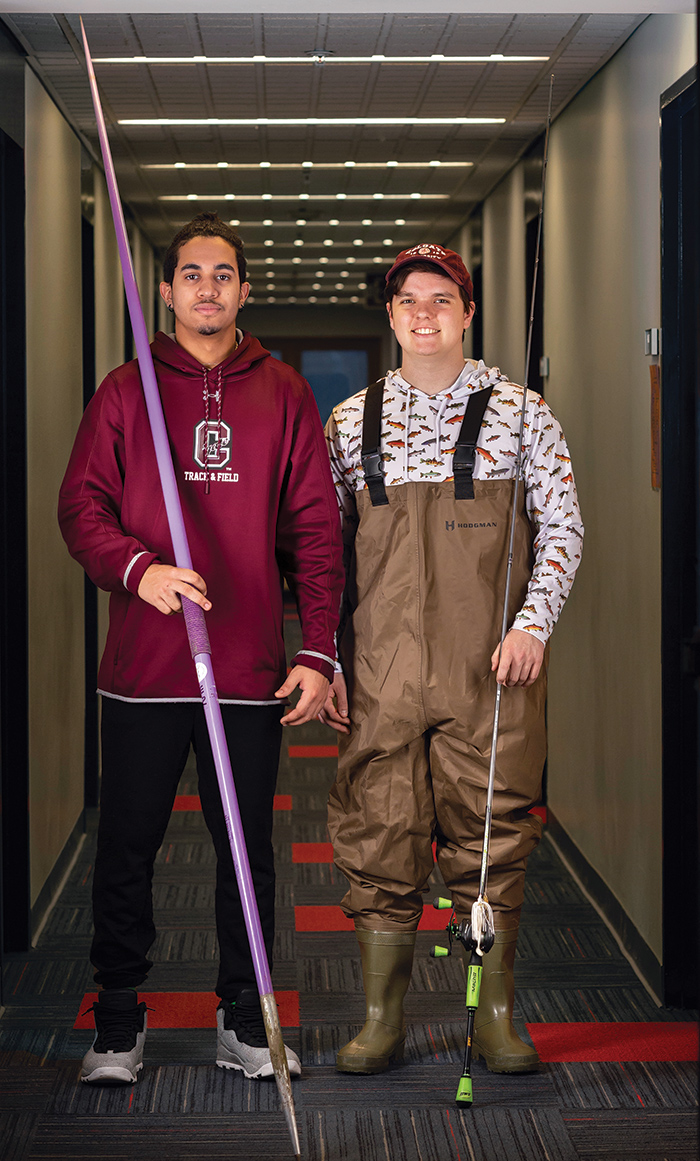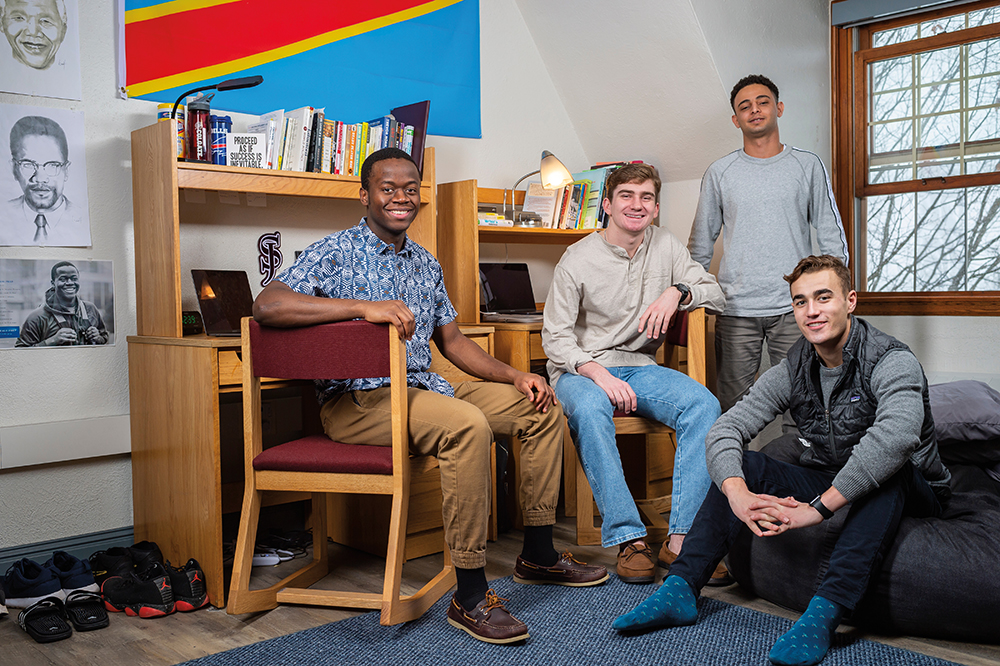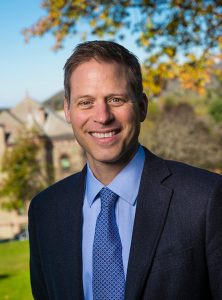Colgate’s living-learning communities build strong foundations for the University’s diverse student body. Meet roommates from each of the Residential Commons.
Ciccone Commons
Led by Mark (associate university chaplain, Catholic campus minister) and Rebecca Shiner (professor of psychological and brain sciences)
On the surface, they couldn’t be more different. But that hasn’t stopped Manny Cruz ’22 and Jackson Hoit ’22 from becoming friends — and compatible roommates. Cruz and Hoit do have a few things in common. They both applied early decision. Both admit to being “pretty messy” and like to go to bed late. When filling out a roommate agreement handed out by their community leader, the two took approximately a minute to fill it out. “We had agreed upon everything almost instantly,” Hoit says.
Hometown: Bronx, N.Y.
Major ideas: Considering majoring in English with a minor in creative writing
Extracurriculars: Indoor and outdoor track; Cruz ran the 200 and 400 meters until an injury set him back. While healing, he’s training to throw javelin.
Personal interests: “I write poems.”
Why Colgate: “My high school track coach coached [Colgate assistant coach] Antonio Bulagay. I had that connection, then I found out that Colgate is a smaller, rural school, which I wanted.”
Brought from home: Above Cruz’s bed hangs a Dominican Republic flag, in honor of his family. Underneath rests a racing baton from when his high school team made nationals during his senior year.
Hometown: Stafford, Va.
Major ideas: “Chemistry is my main squeeze. I love it.”
Extracurriculars: Orchestra (cello), Anglers’ Club
Personal interests: Fishing — anytime, any place. “I caught more than 100 bass in Taylor Lake last semester. There is awesome trout fishing too. And, of course, there’s ice for three or four months out of the year for ice fishing.”
Why Colgate: Family friend Erika Davis ’97 encouraged Hoit to look into Colgate. He found that “this place has everything I want outdoors-wise.”
Brought from home: Below the fishing poles on his walls, Hoit hung a fish painting above his bed, done by his girlfriend.
Ciccone gatherings: One of the highlight events was a birthday party in the fall for Diane Ciccone ’74, P’10, after whom this first commons was named (see “Household Names” sidebar below for more). Ciccone even joined the students for the celebration.
Hancock Commons
Led by Antonio (associate professor of history) and Pilar Mejía-Barrera (senior lecturer in Spanish)
Same name, same sneakers. Those are the traits that Emily Karavitch ’21 and Emily Cruz Gonzalez ’21 initially bonded over when they met during first-year orientation. As they’ve learned more about each other and spent time together, their friendship has developed and deepened.
Karavitch remembers walking up to Cruz Gonzalez that first day on campus. It was the 2017 solar eclipse, families had just said their goodbyes, and the students were heading to icebreaker activities.
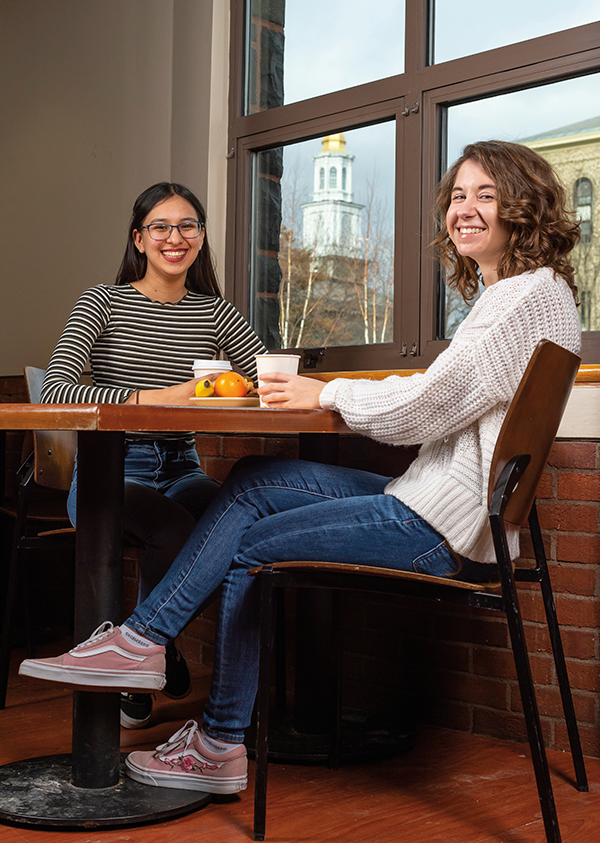
Cruz Gonzalez (left) and Karavitch meet up every night for dinnertime, often at Frank (pictured here). Photo by Mark DiOrio
“We were wearing the same navy Converse when I went up to her,” Karavitch recalls. “The interaction was along the lines of ‘first you steal my name, now my shoes?’ It broke the tension and then we started to become more familiar with one another.”
The Emilys (as they’re often called) are both first-generation college students who became fast friends with each other and others in Hancock Commons over that fact during pre-orientation.
Karavitch and Cruz Gonzalez decided to room together this year, and the group as a whole is still tight.
“Many of the people who live here are closely knit because there are a lot of first-generation and OUS [Office of Undergraduate Studies] students in Parke House,” Karavitch says.
Hometown: Phoenix, Ariz.
Major ideas: Double major in computer science and English
Why Colgate: “I applied only to schools on the East Coast because I wanted to experience seasons — something I didn’t get in Phoenix. When I came to visit and stayed overnight for April Visit Days, I really liked the sense of community.”
Extracurriculars: Colgate Coders, Latin American Student Organization, Office of Admission tour guide
On her wall: A poster from the 2018 Grace Hopper Celebration — the world’s largest gathering of women in technology — which she attended in the fall with the coding club
Hancock gatherings: “I’m part of the commons council — a group of residents from every tower that meets with our residential fellow,” Karavitch says. “We voice our opinions about what we want to see and do. Last semester, we put on movie showcases.”
Hometown: Scranton, Pa.
Major ideas: Double major in history and German
Why Colgate: “My high school German teacher was Jacquelyn Harris Schulte ’08. She was really important to me and influential. She was also a history and German major, and she suggested I look into Colgate. When I toured the campus, I fell in love. “Also, study abroad is a huge reason for why I’m here. I’m going to Freiburg next year with the German Study Group.”
Extracurriculars: Picker Art Gallery student curatorial and research assistant, Maroon-News writer, research assistant in Professor Dan Bouk’s History Lab, History Club
Brought from home: Threat Level Midnight T-shirt (a reference to The Office, because she’s from Scranton).
Group efforts:
→ Both Karavitch and Cruz Gonzalez say they were interested in Colgate because of the low student-faculty ratio. Case in point: Last year, Karavitch signed up for an advanced German course and ended up being the only student in the class. Not only did she hone her language skills, but she also provided Cruz Gonzalez with an interesting anecdote for admission tours.
→ A bulletin board on their wall features Karavitch’s Maroon-News clips. Cruz Gonzalez hung the board and pins up her roommate’s writings — an idea she got from the students she stayed with during April visit days. “It makes me stupidly happy,” Karavitch says.
Household Names
Meet the people for whom each Residential Commons was named
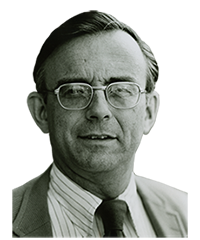
Princeton University graduate Coleman Brown served as a Presbyterian minister in inner-city Chicago before coming to Colgate in 1970 to teach philosophy and religion. In 1974, he also took on the role of university chaplain, welcoming “believers, seekers, and doubters” to the church. He later served as dean of students, chair of the diversity committee, and chair of the department of religion and philosophy. Brown’s many accolades included the Phi Eta Sigma teaching award, the Alumni Corporation Distinguished teaching award, and the Colgate prize for inspirational teaching.
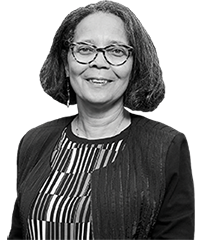 Political science major Diane Ciccone ’74, P’10 was one of the first 132 women to enroll at Colgate. She is an attorney and administrative law judge as well as a documentary filmmaker, an author, and a TV producer. Ciccone is a founding member of Colgate’s Alumni of Color organization and has served on the Alumni Council and Board of Trustees. She created a fund to support the ALANA Cultural Center and established its library with books by authors of color. The documentary Path of Duty, which traces the early experiences of students and alumni of color at Colgate, was inspired by her research.
Political science major Diane Ciccone ’74, P’10 was one of the first 132 women to enroll at Colgate. She is an attorney and administrative law judge as well as a documentary filmmaker, an author, and a TV producer. Ciccone is a founding member of Colgate’s Alumni of Color organization and has served on the Alumni Council and Board of Trustees. She created a fund to support the ALANA Cultural Center and established its library with books by authors of color. The documentary Path of Duty, which traces the early experiences of students and alumni of color at Colgate, was inspired by her research.
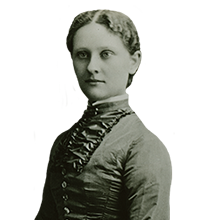
The daughter of a Hamilton orchard farmer who ran the University’s boarding hall, Mabel Dart Colegrove was accepted into what was then Madison University at age 14. She took classes alongside male students from 1878–82. Despite her years of study, Dart Colegrove could not receive a degree from Madison, so she transferred her credits to Vassar College for her final semester and received a degree. She went on to work as a teacher and librarian. In 1947, Colgate recognized her as the University’s first alumna.
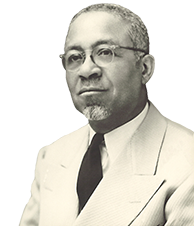 Holding both a BA and divinity degree from Benedict College in South Carolina, Gordon Blaine Hancock came to Colgate to receive his second BA (1919) and BD (1920) as one of only two black students at the University at that time. In 1921, he received a Master of Arts from Harvard and began teaching as a sociology professor at Virginia Union University (VUU). He is credited as teaching the first-ever academic course on race relations and organized VUU’s school of race relations. He also served as a Baptist pastor and was a spokesman for African American equality.
Holding both a BA and divinity degree from Benedict College in South Carolina, Gordon Blaine Hancock came to Colgate to receive his second BA (1919) and BD (1920) as one of only two black students at the University at that time. In 1921, he received a Master of Arts from Harvard and began teaching as a sociology professor at Virginia Union University (VUU). He is credited as teaching the first-ever academic course on race relations and organized VUU’s school of race relations. He also served as a Baptist pastor and was a spokesman for African American equality.
Brown Commons
Led by Jeff Bary (physics and astronomy) and Mary Simonson (film and media studies)
If you walk through the second floor of East Hall, you might hear the belly laughs of Willa King ’22 and Teagan Mackey ’22. Both having a quick sense of humor, the roommates keep their relationship fun with TV comedies. But they also connect on a more serious level, with a shared interest in social justice issues.
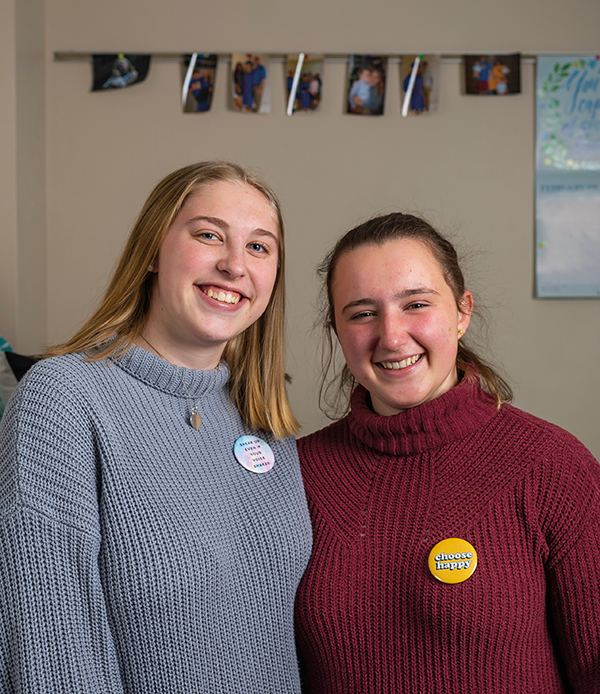
Mackey (left) and King show off buttons they made together in the student organization Do Random Acts of Kindness. Photo by Mark DiOrio
Hometown: Manhattan, N.Y.
Major ideas: Economics
Extracurriculars: Hamilton Fire Department volunteer, club field hockey
On her wall: Maps from her 30-day backpacking trip through Wyoming; a print of two Volkswagen Beetles crashing — her nickname is “buggy.”
Why Colgate: Having grown up playing ice hockey, King came to Colgate once to play in a tournament. The campus made a good first impression, and later, one of her best friends enrolled. King decided to visit again and apply. “I realized I had found something that was missing from every other school that I’d looked at — I loved how passionate everybody was about Colgate.”
Hometown: Oneonta, N.Y.
Major ideas: History
Extracurriculars: University Church board of deacons, Friends First
Why Colgate: “Other schools that I’d been to, people were walking by themselves or staring at their phones. But when I visited here, everybody was walking in groups, and they were talking to each other. They smiled at you when you walked by. It felt much more welcoming.”
Sweet digs: “Our room setup is kind of interesting,” Mackey says. King arrived first, so she claimed the “good bed” — considered so because it’s against the wall opposite the door. So, it’s only fair that Mackey got the “good closet,” at the end of King’s bed. The result? A shared space, in the true sense of the word.
Brown gatherings: The roommates have gone to several dinners at their social house. “Those are really fun because we all help make dinner and eat it together,” King says. “It’s definitely more of a home environment and somewhere we can relax as a group.”
 Group efforts:
Group efforts:
→ Both King and Mackey are passionate about giving back to their community — they’re active members of Do Random Acts of Kindness (DoRAK), a student organization. Through DoRAK, they’ve baked cookies for strangers, made buttons with encouraging messages, and designed bookmarks to leave in books at Case Library.
→ King and Mackey often have deep conversations about social issues, like women’s rights. It’s an area they both want to explore after graduation, Mackey through nonprofit work and King through law. “We talk a lot about injustice and inequality, and how we want to try to fix it,” Mackey says. Who knows, maybe they’ll work together once they’re off the hill.
Dart Colegrove Commons
Led by April Baptiste (environmental studies) and Aurelius Henderson (assistant dean for administrative advising)
The pastime that brings four Stillman suitemates together isn’t in central New York — it’s across the pond. Jack Kohler ’22 and Thomas Dunia ’22 are fans of English Premier League team Manchester United. Edward Bass ’22 likes following along with several teams, and Ebrahim Almansob ’22 will watch if there’s a big game. When they have free time, they also play FIFA together.
Hometown: Democratic Republic of the Congo/Buffalo, N.Y.
Major ideas: “I came here because of the international relations program, so possibly an international relations major. Economics is an interest of mine, so I’ll probably minor in that.”
Why Colgate: “I wanted to go to a liberal arts school. Colgate happened to be just three hours away and a perfect fit.”
On his wall: Sketches of Barack Obama, Nelson Mandela, and Malcolm X. “Those are figures from the past whom I look up to. When pretty big things happened in history, they captured my attention.” Also, because he is originally from the Democratic Republic of the Congo, he has a flag from that country.
Coming to America: Born in the Congo in 1998, Dunia and his family left because of the civil war. “I had to go to Tanzania, to Mozambique, and then to South Africa, and then back to Mozambique,” he says. In 2005, he and his family moved to Dallas and in 2009, they moved to Buffalo.
Hometown: San Antonio/Dallas, Texas
Extracurriculars: Men’s soccer
Major ideas: Economics, sociology, philosophy
Why Colgate: “I wanted to find a school with a good balance of academics, social life, and athletics, and Colgate really stood out.”
The soccer lifestyle: In middle school, he moved to Dallas to play for the Dallas Texans USSF Developmental Academy Team. An opportunity that he says allowed him to “continue playing soccer for an intense team.”
Being in Dart Colegrove: Living in the renovated Stillman Hall, the suitemates say it’s an easygoing environment — which they appreciate given their hectic schedules. “It’s been really nice living here,” Bass says.
Hometown: Kohler, Wis.
Extracurriculars: Men’s soccer
Why Colgate: I was looking for a balance with both my education and soccer, because I think after soccer, I want to go into business. Colgate had all the qualities I was looking for in a college.”
Sticking with soccer: “I grew up in a small town in Wisconsin. It was a tight-knit community, and I was always playing soccer. I would commute an hour for three or four days a week to play in Milwaukee [where there were more opportunities]. I just kept pursuing it.”
Hometown: Yemen/Brooklyn, N.Y.
Major ideas: Biology, economics
Extracurriculars: Afro-beat dance club, Muslim Student Association, Black Student Union
Why Colgate: Both Almansob and Dunia are part of Colgate’s Office of Undergraduate Studies (OUS) program. OUS was one of the major reasons Almansob chose Colgate, he says.
Coming to America: “I was born in Yemen when the civil war started. My dad brought me and my twin brother to Brooklyn in my freshman year of high school. It was challenging because I did not speak English. However, I put in the work, and everything paid off when I was accepted to Colgate three and a half years later.”
Future goals: Almansob hopes to attend medical school after Colgate.
On his wall: A world map with a mark on Yemen “to remind myself of my humble beginnings and my childhood stories.”
Q&A with Paul McLoughlin II
Vice President and Dean of the College
Colgate Magazine: What are Colgate’s Residential Commons?
Paul McLoughlin II: The four Residential Commons bring first- and second-year students together with members of Colgate’s staff and faculty. The Residential Commons are integral to the University’s academic mission and to our residential liberal arts education; they help extend where learning occurs, whether in first-year seminars, residence hall floors, or other co-curricular opportunities. They also provide intergenerational peer mentoring and leadership opportunities for upper-level students.
CM: What is the philosophy of the initiative?
PM: Residential colleges in American higher education are inspired by models at the universities of Oxford and Cambridge that place academic activities within a residential setting and where students are affiliates of the Residential Commons as members for their collegiate career. Colgate’s Residential Commons focus on these intellectual connections with faculty and among students by linking the first-year seminar to where students live (some are even taught within the Commons) and by forging strong co-curricular connections within these four living-learning communities.
CM: What are your goals with the Residential Commons?
PM: One goal is that they are inclusive in what they provide in order to meet the needs of a diverse student body. Students may join weekly dinners with faculty; perform community service; participate in the intramural programs on behalf of their Residential Commons; or take advantage of trips to places like museums or ski slopes. They should evolve as our students’ needs change. Regardless of the ways in which students connect with each other, the Residential Commons need to offer every student a foundational community. That’s critical to building an academic community where students feel that they belong, are willing to take risks, explore new ideas, and grow.
CM: What are some upcoming initiatives?
PM: A recent and important connection was forged between the four Residential Commons and the roughly five dozen first-year seminars taught by our teacher-scholar faculty. This year, the Class of 2022 students were housed according to their intellectual interests and with their fellow seminar participants (with some exceptions for the scholar cohorts such as the Benton Scholars, Alumni Scholars, and Office of Undergraduate Studies students). While still a developing connection, this provides students with opportunities to extend the conversations that begin in seminars in the residence hall lounges. On the social side, Residential Commons are offering signature events such as coffeehouses, brunches, and weekly dinner discussions with faculty and staff. For example, a new series in Brown Commons, called “Seekers, Believers, and Doubters,” brought students together to answer important questions on identity and meaning.
The two new residence halls opening in the fall will provide Brown Commons and Dart Colegrove Commons with social, academic, and study spaces on the hill. As the University deepens connections between the Residential Commons social houses along Broad Street and their residence halls on the hill, juniors and seniors will offer additional peer mentoring, leadership, and social programs for first-year and sophomore students.

